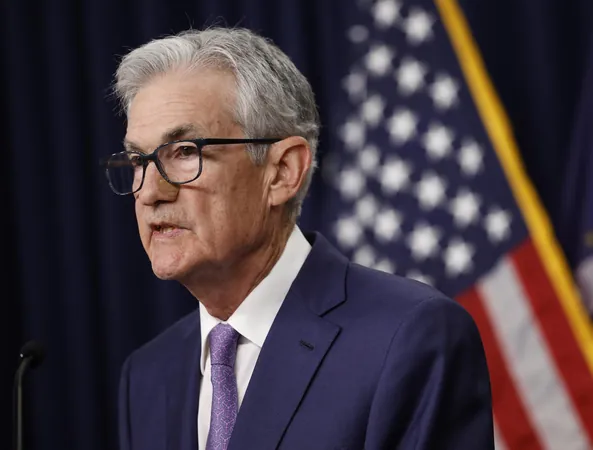
Fed Poised for Historic Rate Cut: What Does It Mean for the Economy?
2024-09-16
Introduction
The Federal Reserve is gearing up for a significant shift in monetary policy as it prepares to announce its first interest rate cut in four years this Wednesday. This pivotal meeting is expected to herald the end of a stringent inflation-fighting strategy that has dominated the economic landscape since the 1980s.
Esther George, the former president of the Kansas City Fed, emphasizes the importance of this meeting, stating, “This is a big meeting. It’s one that’s been foreshadowed since late last year and long expected.” The central bank is anticipated to reduce its benchmark rate by a quarter percentage point, bringing it down to a range of 5.0-5.25%. This decision follows an unprecedented period of aggressive rate hikes aimed at curbing inflation.
Market Expectations
As speculation runs high among investors regarding the magnitude of the rate cut, market expectations have fluctuated significantly. Just last week, traders were wrestling with a near 50-50 chance of a 25-basis-point cut versus a deeper 50-basis-point reduction. Following favorable inflation and job market data, the likelihood of a 25-basis-point cut has surged to around 85%. With the presidential election looming in about six weeks, some Republican candidates, including former President Trump, have voiced their concerns about timing, calling for the Fed to hold off on such decisions until after the election.
Impact on Consumers and Businesses
This rate cut marks the beginning of a potential sequence of reductions, with estimates indicating that the Fed could maintain lower rates through 2025 and 2026. Such a monetary environment would lower borrowing costs for American consumers, making it easier for them to finance home purchases, vehicles, and even day-to-day expenditures through credit cards. Businesses, too, are set to benefit as accessing loans becomes more affordable, fueling further investment and operational growth.
Future Projections
Following the rate cut announcement, Fed officials will also share updated interest rate projections, commonly known as the "dot plot," indicating their outlook for future cuts. Industry experts, like Wilmington Trust’s chief economist Luke Tilley, anticipate an immediate cut of 25 basis points, with two more similar reductions likely to follow this year. Tilley argues that the Fed appears to be lagging behind the curve in terms of adjusting rates and suggests that the communication around rate cut plans will be as crucial as the actions themselves.
Inflation and Job Market Dynamics
Looking ahead, many economists agree that a consistent trajectory of rate cuts, including possible larger cuts, should be framed carefully to avoid unsettling the markets. The Fed recognizes that its messaging holds substantial weight, particularly in shaping market expectations. Amid these developments, there are signs that inflation is moving closer to the Fed's long-term target of 2%. Recent Consumer Price Index (CPI) data shows a gradual decline in inflation rates, with figures hovering around 3.2% in August and July—down from previous months. Such a trend supports Fed confidence in moving forward with rate reductions.
However, there's also a notable cooling in the job market, with job creation numbers slowing over recent months. The Fed has signaled a shift in focus toward labor market conditions, with Chair Jay Powell reaffirming the importance of supporting job growth while tackling inflation.
Press Conference and Future Outlook
On Wednesday, along with the interest rate decision, Powell is set to deliver a press conference to discuss the Fed's forecasts for unemployment, inflation, and the broader economic outlook. Analysts will be keenly watching for indications of forthcoming policy adjustments and the Fed's narrative around potential larger cuts.
Conclusion
As we navigate this complex economic landscape, concerns remain regarding potential recession risks. Although recent job market rebounds have alleviated some fears, experts warn that the economy’s growth is precarious and sensitive to shocks, such as fluctuations in oil prices or volatility in stock markets. Political policies proposed by candidates like Trump and Harris could further complicate matters for American consumers in the coming year.
Stay informed and ready to adapt to the upcoming changes! The next few weeks are crucial as we look towards how the Fed’s actions will reshape the economic landscape.


 Brasil (PT)
Brasil (PT)
 Canada (EN)
Canada (EN)
 Chile (ES)
Chile (ES)
 España (ES)
España (ES)
 France (FR)
France (FR)
 Hong Kong (EN)
Hong Kong (EN)
 Italia (IT)
Italia (IT)
 日本 (JA)
日本 (JA)
 Magyarország (HU)
Magyarország (HU)
 Norge (NO)
Norge (NO)
 Polska (PL)
Polska (PL)
 Schweiz (DE)
Schweiz (DE)
 Singapore (EN)
Singapore (EN)
 Sverige (SV)
Sverige (SV)
 Suomi (FI)
Suomi (FI)
 Türkiye (TR)
Türkiye (TR)